Introduction
Water. In the arid climate of the Great Basin it is the most vital resource available. Both humans and natural ecosystems rely on this scarce resource for their livelihood and well being. Nowhere is this more apparent than the Walker River Basin in westcentral Nevada. The water flowing through the basin provides for a multitude of activities, including agricultural production.
Since the settlement of the region, agricultural activities have played a vital role in the area’s economy, culture and sustainability. In 1852, the first diversion of the Walker River was created to give local agriculturalists a sufficient irrigation supply. In the early 1920s and 1930s, several reservoirs were constructed to aid in the supply and management of water for both agricultural and human consumption. Finally, during the 1960s the pumping of groundwater for supplemental use became a feasible practice for those in the basin (Tracy, 2004).
In recent years, the issue of water usage in the area has come to the forefront of water resource management discussions as the demand for water increases. In a location where up to 90 percent of consumptive water use can be attributed to agriculture, it is important to explore alternative methods of agricultural production that can help alleviate the burden on the Walker River Basin. (USDA-ERS, 2008)
This fact sheet will explore the results of a 2007 survey in which landowners and producers in the basin were asked about their willingness to adopt such practices. It will also present a brief discussion on some possible alternative practices that are generally less water intensive, but could maintain standards of production and economic stability in the region. During the 2007 study, 70 surveys were completed, 22 percent of the 320 distributed by mail to landowners in the Walker River Basin.
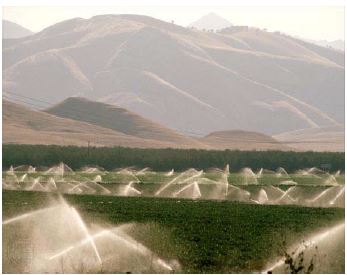
Survey and Results
Respondents completing surveys were asked two questions regarding their willingness to implement practices that would reduce their water usage in agricultural production. The first question asked if they would be willing to plant water conserving crops on their land, while the second question asked whether they would be willing to utilize alternate irrigation strategies on the crops they currently produce. For each question, respondents were provided a scale of responses ranging from “definitely yes” to “definitely no.”
In addition to the water conservation questions, survey respondents were asked to indicate how long they or their family had been active in agriculture (Table 1). Of the respondents who completed the survey, a majority (52.9 percent of respondents) indicated that they or their families have been involved in agriculture for more than 35 years.
Table 1: Years Involved in Agricultural Production
| Years in Production |
Percent of Total Responses |
| Under 5 years |
2.9% |
| 5-15 years |
5.7% |
| 15-25 years |
4.3% |
| 25-35 years |
34.3% |
| More than 35 years |
52.9% |
Willingness to Use Water Conserving Crops
Respondents were asked to address the issue of whether or not they would be willing to implement water conserving crops on their land (Figure 1). Overall, 45 percent of respondents indicated that they would consider making such a change, 33 percent were unsure and 22 percent would most likely not be willing to change to low-water use crops.
Figure 1: Willingness to Implement Water Conserving Crops on Existing Land
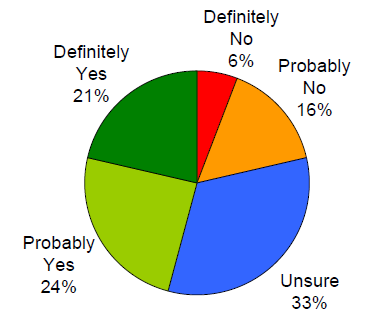
Data From Figure 1
The responses to the first question were analyzed along with the respondents’ number of years in agriculture to compare willingness to plant water conserving crops between respondents who have been involved in agriculture for more than 35 years and those who have been involved for less than 35 years (Figure 2). Within this comparison, little difference was found between the two groups. The exception to this generalization is that respondents involved in agriculture for less than 35 years more frequently indicated that they were unsure about implementing low-water crops (by a margin of six percentage points) and less frequently responded that they were definitely willing to do so (also by a margin of six percentage points).
Figure 2: Willingness to Implement Water Conserving Crops by Years in Agriculture
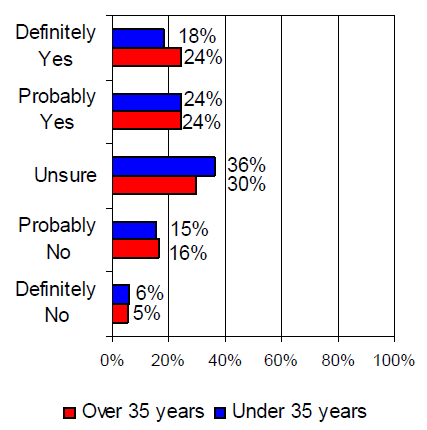
Data From Figure 2
Willingness to Use Alternate Irrigation Strategie
Respondents were then asked to consider whether they were willing to use alternate irrigation strategies on their existing crops (Figure 3). Responses to this question were similar to those of water conserving crops. Forty-seven percent indicated that they were willing to implement irrigation methods that use less water, 35 percent were unsure, and 18 percent were not willing to change their irrigation strategies. However, a larger proportion of responses to this question were “probably yes” as compared to “definitely yes,” while responses to the question related to low-water crops presented a much closer distribution between “probably yes” and “definitely yes.”
A greater variance in response frequencies between the two groupings was also present when responses were compared based on respondents’ years in agriculture (Figure 4). Respondents involved in agriculture for more than 35 years indicated more often that they would probably be willing to implement alternative irrigation than their counterparts. Conversely, those involved for less than 35 years were more uncertain about their willingness to change to a low-water use irrigation strategy.
Figure 3: Willingness to Use Alternate Irrigation Strategies on Existing Crops
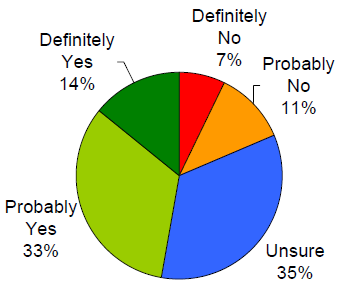
Data From Figure 3
Figure 4: Willingness to Use Alternate Irrigation Strategies by Years in Agriculture
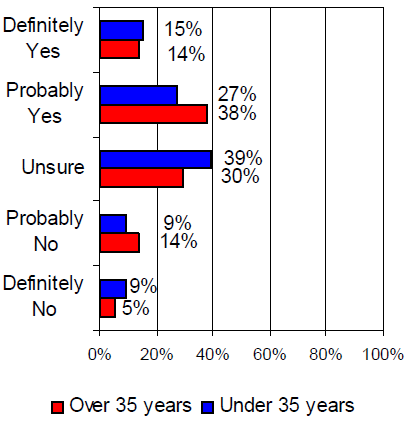
Data From Figure 4
Alternative Cropping Strategies
After the study was completed, a listing of a number of alternative cropping strategies was compiled. The following paragraphs present brief discussions of selected water conserving crops or crop practices that can be applied in the Walker River Basin.
The crops presented here (listed in Table 2) can be broken into three main groups: vegetable crops, forage crops and grain crops. These crops have been selected as the most common alternatives, however, other possibilities such as cowpeas, mungbeans, safflower and sorghum (not included here) may also present good alternatives.
Table 2: Alternative Cropping Strategies
| Crop |
Days to Maturity |
Season(s) |
Drought Tolerance |
Duration |
Use(s) |
| Lettuce (baby leaf) |
28-40 |
Summer |
Low |
Annual |
Fresh market |
| Onions |
90-150 |
Spring, Summer |
High |
Annual |
Fresh market, Seed |
| Switchgrass |
N/A |
Summer |
Medium |
Perennial |
Bionmass production (fuels), Erosion abatement |
| Great Basin Wild Rye |
N/A |
Spring, Summer |
Medium |
Perennial |
Fodder, Grazing, Erosion abatement, Seed |
| Barley |
100-120 |
Spring, Summer |
Medium |
Annual |
Fodder, Food (meal), Malt |
| Teff |
50-65 |
Spring, Summer |
High |
Annual |
Specialty flour products |
The first vegetable crop, lettuce, is included because of the potential production practices that serve as a water conserving method. Currently being produced in the region, lettuce, cut for the baby leaf market, may hold some promise as an alternative vegetable crop for Walker River Basin producers. The key is to focus on the baby leaf market, cutting the heads at an early stage in development. By cutting early, producers are able to grow in late spring when there is a greater chance of precipitation and snow melt and finish with lowwater use irrigation such as drip-line or sprinklers. Late cold snaps are the largest concern, as leaf lettuce is highly susceptible to frost damage.
Nevada onions are one of the state’s most commonly-produced crops, and are generally drought and heat tolerant (Nevada Agriculture in the Classroom, 2008). Onions adapt well to the regional soil conditions and require surface watering because of their shallow root systems.
The market for switchgrass is newly emerging as the need for raw materials for alternative fuels increases. It is commonly considered one of the best candidates for cellulosic ethanol production and has the potential to become a valuable crop in the future. Typically planted as a range crop, switchgrass can be used to control erosion as well as for forage. It is fairly drought tolerant, can adapt well to poor soil and climate conditions, and has a rapid growth rate.
Great Basin or Basin Wild Rye is also a range and forage crop. It can be used to graze many livestock species and is effective in preventing soil erosion from wind. It can be planted to harvest seed for retail in the ornamental horticulture market and generally requires little irrigation.
Two row barley has several uses. It can be sold as feed for livestock, milled into meal, or used as malt for beer production, as well as a number of other possible applications. Many varieties are highly drought tolerant and can withstand most temperature variation and high winds. It can also be intercropped with some species for use as a protective wind strip, but such application may be limited by its slower growth rate.
Teff (tef) is an African grain crop just starting to see an emergence in the U.S. production market. Originating in Ethiopia, the crop is well-suited to the arid climate of the Walker River Basin and the state as a whole. It is highly drought tolerant, has moderate to low nutrient requirements and has an extremely accelerated date-to-maturity, making it a good candidate for double-cropping. While the domestic market for teff is currently limited, its largest possibility for growth may be in the specialty foods market, as the flour produced from the grain is often used in gluten-free bread and cereal products.
Conclusions
Overall, the 2007 survey found that a larger number of Walker River Basin producers are willing to adopt alternative water-saving practices than those who are not. However, a nearly equal proportion of producers are unsure about their willingness to implement low water use crops and alternative irrigation strategies. For those considering such changes in production practices, a number of opportunities exist that can help reduce the use of water, and therefore, the total cost of irrigation. The Walker River Basin is facing a new challenge, and the success of agricultural producers depends on the innovation and adaptation of new strategies to increase profitability and allocate resources.
References
Carreira, R.I., A.L. Stoecker, F.M. Epplin, J.A. Hattey, and M.A. Kizer (2006). “Subsurface Drip Irrigation Versus Center-Pivot Sprinkler for Applying Swine Effluent to Corn.” Journal of Agricultural and Applied Economics (38)3:645-658.
Cornell University Cooperative Extension. “Vegetable Varieties for Gardeners.” Online. Available at: Vegetable Varieties for Gardeners. Accessed May 2008.
Croissant, R.L. and J.W. Echols (2003). “Planting Guide for Field Crops.” Colorado State University Extension Fact Sheet Number 0.103.
Garrison, N. “Planting Your Vegetable Garden” (2005). Publication of University of California Cooperative Extension, Santa Clara County. Online. Available at Planting Your Vegetable Garden. Accessed May 2008.
Jarrett, A.R., and R.E. Graves (2002). “Irrigation of Liquid Manures with Center-Pivot Irrigation Systems.” Pennsylvania State University
Nevada Agriculture in the Classroom. “Nevada Onions and Garlic.” Publication of the Nevada Heritage Foundation and the Agricultural Council of Nevada. Online. Available at: Nevada Onions and Garlic. Accessed May 2008.
Stallknecht, G. F. (1997). “Teff.” Purdue University, Center for New Crops and Plant Products Fact Sheet. Online. Available at Teff. Accessed May 2008.
Tracy, J. C. (2004). “Environmental Impacts from Water Management in a Closed Basin: Walker Lake, Nevada.” Southwest Hydrology (3)4:14-17.
USDA Natural Resources Conservation Service. 2008. “Plants Database.” Online. Available at: Plants Database. Accessed May 2008.
Curtis, K., Emm, S., and Entsminger, J.
2008,
Landowner Willingness to Adopt Alternative Cropping and Irrigation Strategies in the Walker River Basin,
Extension | University of Nevada, Reno, FS-08-19


